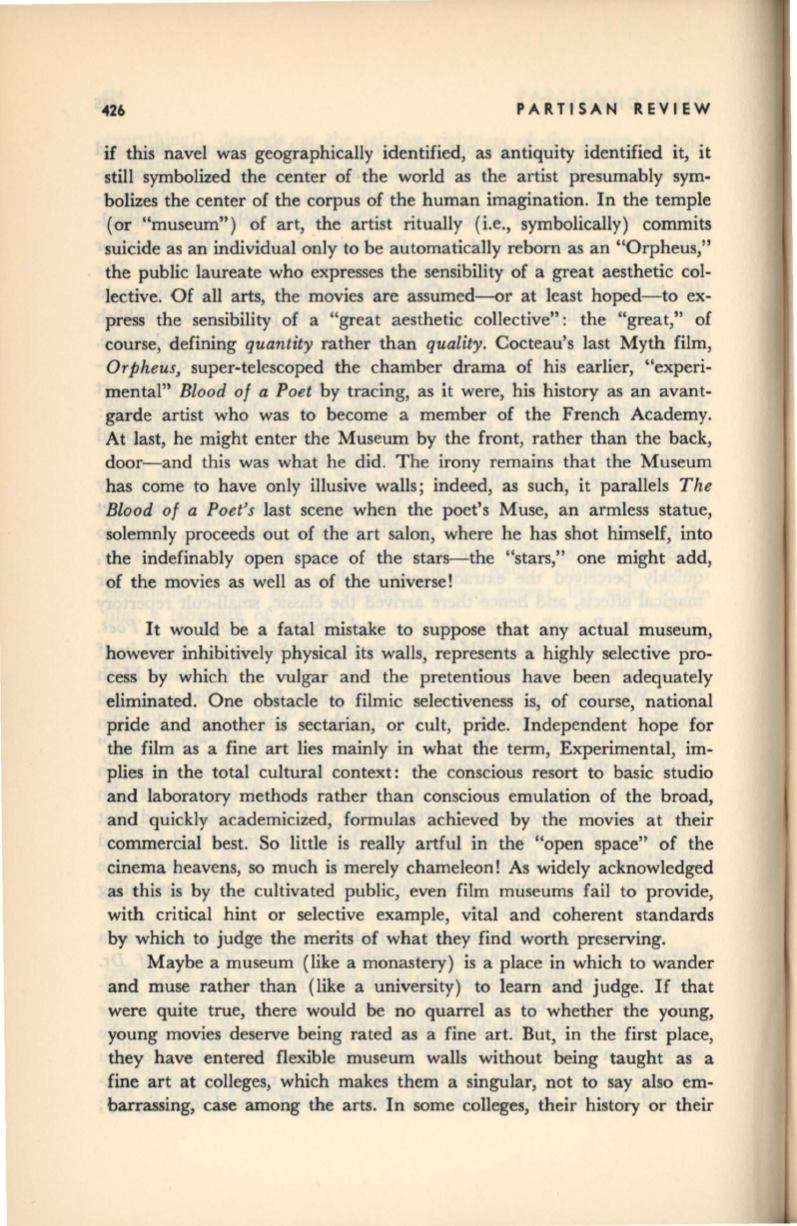
426
PARTISAN REVIEW
if this navel was geographically identified, as antiquity identified it, it
still symbolized the center of the world as the artist presumably sym–
bolizes the center of the corpus of the human imagination. In the temple
(or "museum") of art, the artist ritually (i.e., symbolically) commits
suicide as an individual only to be automatically reborn as an "Orpheus,"
the public laureate who expresses the sensibility of a great aesthetic col–
lective. Of all arts, the movies are assumed-or at least hoped-to ex–
press the sensibility of a "great aesthetic collective": the "great," of
course, defining
quantity
rather than
quality.
Cocteau's last Myth film,
Orpheus,
super-telescoped the chamber drama of his earlier, "experi–
mental"
Blood of a Poet
by tracing, as it were, his history as an avant–
garde artist who was to become a member of the French Academy.
At last, he might enter the Museum by the front, rather than the back,
door-and this was what he did. The irony remains that the Museum
has come to have only illusive walls; indeed, as such, it parallels
The
Blood of a Poet's
last scene when the poet's Muse, an armless statue,
solemnly proceeds out of the art salon, where he has shot himself, into
the indefinably open space of the stars-the "stars," one might add,
of the movies as well as of the universe!
It would be a fatal mistake to suppose that any actual museum,
however inhibitively physical its walls, represents a highly selective pro–
cess by which the vulgar and the pretentious have been adequately
eliminated. One obstacle to filmic selectiveness is, of course, national
pride and another is sectarian, or cult, pride. Independent hope for
the film as a fine art lies mainly in what the term, Experimental, im–
plies in the total cultural context: the conscious resort to basic studio
and laboratory methods rather than conscious emulation of the broad,
and quickly academicized, formulas achieved by the movies at their
commercial best. So little is really artful in the "open space" of the
cinema heavens, so much is merely chameleon! As widely acknowledged
as this is by the cultivated public, even film museums fail to provide,
with critical hint or selective example, vital and coherent standards
by which to judge the merits of what they find worth preserving.
Maybe a museum (like a monastery) is a place in which to wander
and muse rather than (like a university) to learn and judge.
If
that
were quite true, there would be no quarrel as to whether the young,
young movies deserve being rated as a fine art. But, in the first place,
they have entered flexible museum walls without being taught as a
fine art at colleges, which makes them a singular, not to say also em–
barrassing, case among the arts. In some colleges, their history or their


